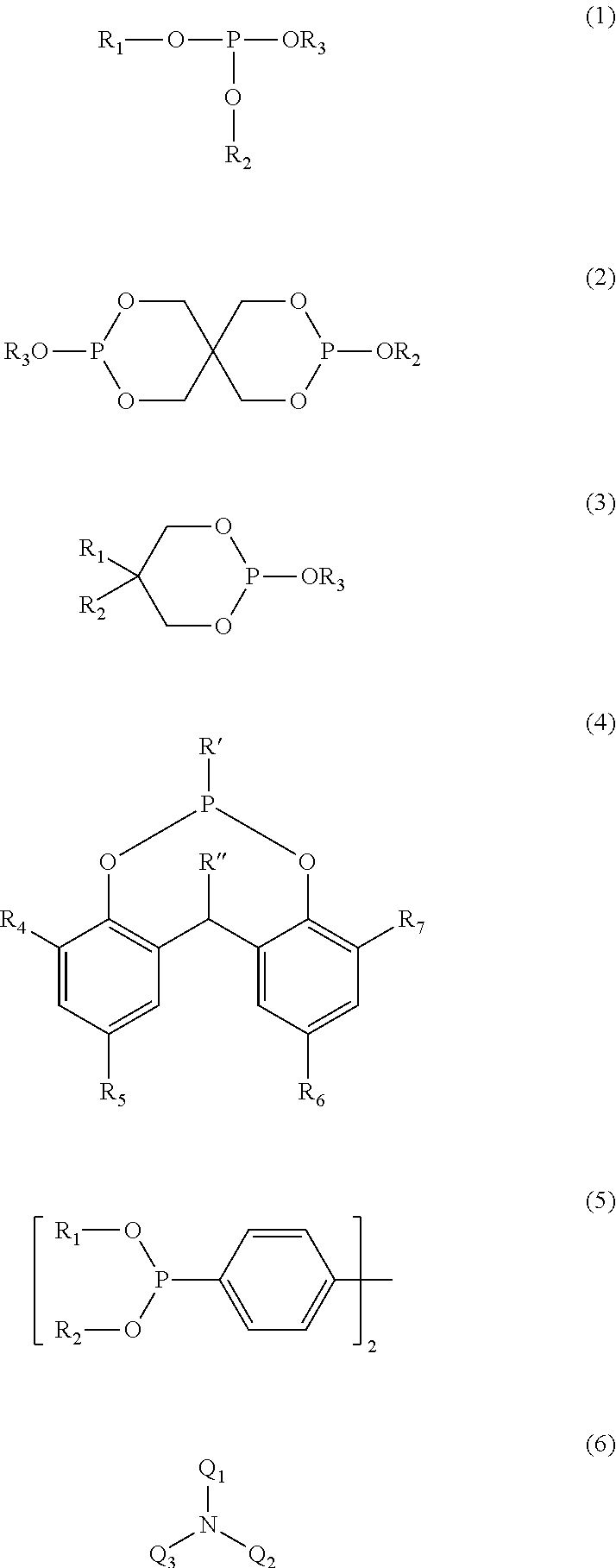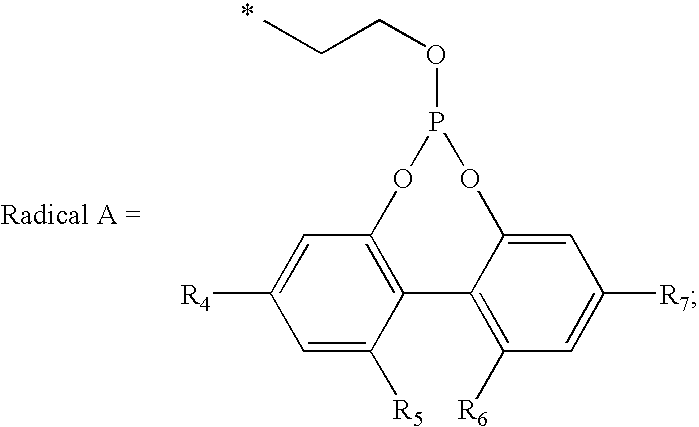Polymer blends
- Summary
- Abstract
- Description
- Claims
- Application Information
AI Technical Summary
Benefits of technology
Problems solved by technology
Method used
Image
Examples
examples
[0083]In the examples, the following procedures were followed. Samples were cut from 20-mil film and then exposed to 70° C. and 100% relative humidity (RH) by suspending the films in the vapor space of sealed jars containing a small amount of water and placed inside a forced air oven set at 70° C. in order to evaluate hydrolytic stability. Small samples were subsequently taken periodically and the molecular weight distribution for the polyester and polycarbonate fractions determined using gel permeation chromatography (GPC). The GPC method for the polycarbonate fraction consisted of first immersing the blends in tetrahydrofuran to selectively extract the polycarbonate. The GPC system used to analyze the polycarbonate fraction consisted of a Perkin-Elmer LC-250 pump, a Perkin-Elmer LC-600 autosampler, and a Perkin-Elmer LC-235 photodiode array UV detector operated at 265 nm. The columns used were a PIgel 5-micron guard, a Mixed-C, and an Oligopore from Polymer Laboratories. The molec...
examples 1-10
[0089]These examples illustrate the detrimental effect of a phosphorus-containing catalyst quencher on the hydrolytic stability of polycarbonate-polyester blends and the unexpected improvement in hydrolytic stability of the blends by the addition of a (HALS). In examples 1-6, polyester A is comprised of 74 mole percent terephthalic acid residues, 26 mole percent isophthalic acid residues and 100 mole percent 1,4-cyclohexanedimethanol residues, based on a total of 100 mole % diacid residues and a total of 100 mole % diol residues, having an inherent viscosity of about 0.74 dL / g and containing approximately 100 ppmw titanium metal and polycarbonate A is a bisphenol A polycarbonate (Makrolon 2608, supplied from Bayer Corporation). In examples 1-6, blends of polyester A and polycarbonate A (3:1 ratio by weight) were melt blended along with combinations of a phosphorus-containing stabilizer (a phosphite) tradename Doverphos 9228 (believed to be bis(2,4-dicumylphenyl)pentaerythritol dipho...
examples 11-14
[0093]These examples illustrate that the improvement in hydrolytic stability by addition of HALS is independent of the method that the HALS is introduced to the blend. Blends of polyesters B and polycarbonate B (70:30 ratio by weight) were melt blended along with combinations of Weston 619 (General Electric Specialty Chemicals) and Cyasorb UV-3529 (Cytec Industries, Inc). The additives were precompounded with polyester B using an 19-mm APV twin-screw extruder at 250° C., 200 RPM at a rate of 5 lbs / hr to produce the following concentrates: Concentrate A consisting of 95 / 5 polyester B / Weston 619, Concentrate B consisting of 95 / 5 polyester B / Cyasorb UV-3529, and Concentrate C consisting of 84 / 5 / 11 polyester B / Weston 619 / Cyasorb UV-3529. The blends were prepared as 20-mil extrusion cast films using a 1″ Killion single-screw extruder at 250° C. and 70 RPM. The films were subsequently conditioned at 70° C. and 100% relative humidity for up to 6 weeks and the molecular weight of the polyes...
PUM
| Property | Measurement | Unit |
|---|---|---|
| Temperature | aaaaa | aaaaa |
| Percent by mass | aaaaa | aaaaa |
| Percent by mass | aaaaa | aaaaa |
Abstract
Description
Claims
Application Information
 Login to View More
Login to View More - R&D
- Intellectual Property
- Life Sciences
- Materials
- Tech Scout
- Unparalleled Data Quality
- Higher Quality Content
- 60% Fewer Hallucinations
Browse by: Latest US Patents, China's latest patents, Technical Efficacy Thesaurus, Application Domain, Technology Topic, Popular Technical Reports.
© 2025 PatSnap. All rights reserved.Legal|Privacy policy|Modern Slavery Act Transparency Statement|Sitemap|About US| Contact US: help@patsnap.com



